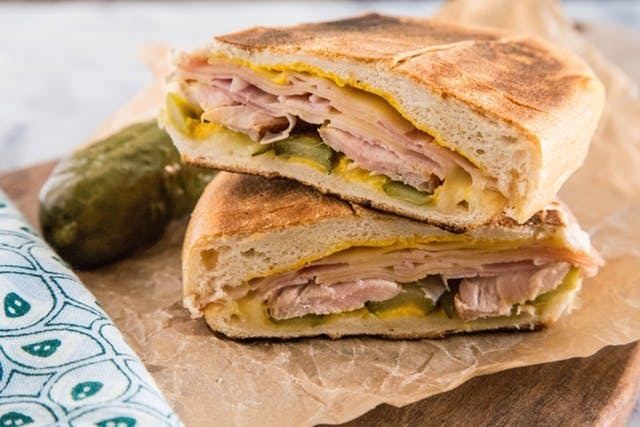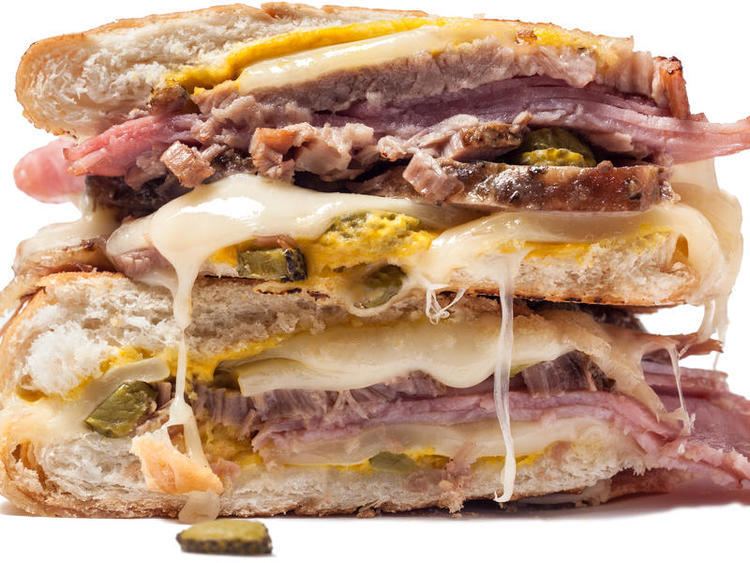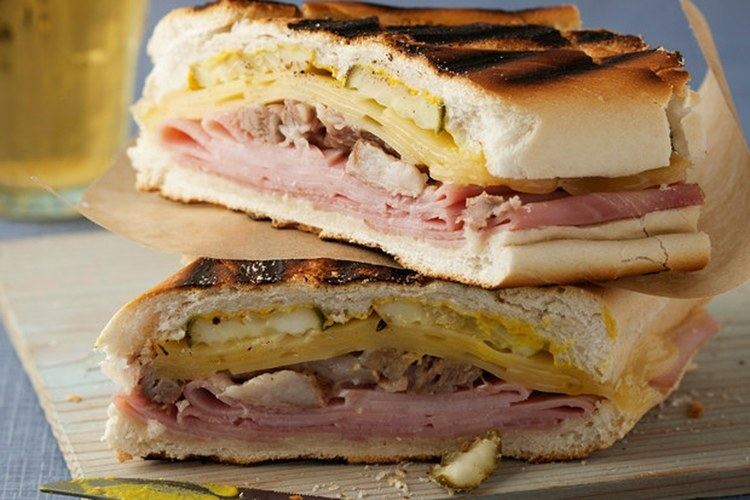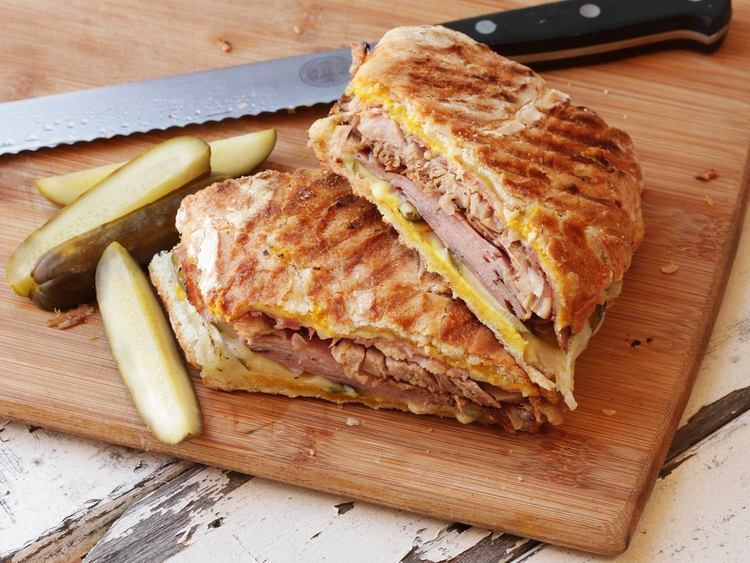 | ||
Alternative names Cuban mix, Cuban pressed sandwich, Cubano, mixto Similar Cuban cuisine, Cuban bread, Swiss cheese, Mojo, Ropa vieja | ||
The cuban sandwich how to make a cubano sandwich
A Cuban sandwich is a variation of a ham and cheese sandwich that originated in cafes catering to Cuban workers in Key West and Ybor City, Tampa, two early Cuban immigrant communities in Florida. Later on, Cuban exiles and expatriates brought it to Miami, where it is also still very popular. The sandwich is made with ham, roasted pork, Swiss cheese, pickles, mustard, and sometimes salami on Cuban bread.
Contents
- The cuban sandwich how to make a cubano sandwich
- Cuban sandwiches from the movie chef
- History
- Ingredients
- Related dishes
- References

In 2012, the "Historic Tampa Cuban Sandwich" was designated as the "signature sandwich of the city of Tampa" by the Tampa City Council.

Cuban sandwiches from the movie chef
History

As with Cuban bread, the origin of the Cuban sandwich (sometimes called a "Cuban mix," a "mixto," a "Cuban pressed sandwich," or a "Cubano") is murky. In the late 1800s and early 1900s, travel between Cuba and Florida was easy, especially from Key West and Tampa, and Cubans frequently sailed back and forth for employment, pleasure, and family visits. Because of this constant and largely undocumented movement of people, culture and ideas, it is impossible to say exactly when or where the Cuban sandwich originated.

Some believe that the sandwich was a common lunch food for workers in both the cigar factories and sugar mills of Cuba (especially in big cities such as Havana or Santiago de Cuba) and the cigar factories of Key West by the 1860s. Historian Loy Glenn Westfall states that the sandwich was "born in Cuba and educated in Key West."

The cigar industry in Florida shifted to Tampa in the mid-1880s, and tens of thousands of Cuban workers moved to the area over the next decade. The first recorded mentions of a distinct Cuban sandwich survive in descriptions of workers' cafés in Ybor City and West Tampa from around 1900, leading other historians to theorize that the sandwich as now constituted first appeared there. Researcher Andrew Huse states that "the old 'mixtos' coalesced into something more distinct – the Cuban sandwiches we know and love – an original Tampa creation."

A travel article published by the Mason City Globe Gazette in 1934 said that Tampa's cooking was "much more distinctive than elsewhere in the state" and lists Cuban sandwiches (along with Cuban bread) among the city's signature foods.
By the 1960s, Cuban sandwiches were also common on Miami cafeteria and restaurant menus, as the city had gained a large influx of Cuban residents after Fidel Castro's 1959 rise to power in their native land. The Communist Revolution caused a wave of Cuban expatriates to settle in other locations as well, and they brought their culture and cuisine with them. Cuban sandwiches and variations thereof are now served in various Cuban exile communities in places such as New York City, New Jersey, Chicago, and Puerto Rico, among others.
Ingredients
While there is some debate as to the contents of a "true" Cuban sandwich, most are generally agreed upon. The traditional Cuban sandwich starts with Cuban bread. The loaf is sliced into lengths of 8–12 inches (20–30 cm), lightly buttered or brushed with olive oil on the crust, and cut in half horizontally. A coat of yellow mustard is spread on the bread. Then sliced roast pork, glazed ham, Swiss cheese, and thinly sliced dill pickles are added in layers. Sometimes the pork is marinated in mojo and slow roasted.
The main regional disagreement about the sandwich’s recipe is whether or not to include salami. In Tampa, Genoa salami is traditionally layered with the other meats, probably due to the influence of Italian immigrants who lived side-by-side with Cubans and Spaniards in Ybor City. In South Florida, salami is left out. An 1934 travel article describes a Tampa Cuban sandwich as a "complete meal" consisting of ham, lean pork, Swiss cheese, soft salami, dill pickle and a "liberal moistening of mustard" served on "very crisp and crusty" Cuban bread. These ingredients are reiterated 27 years later in the first and all subsequent editions of "The Gasparilla Cookbook" (1961), a still-popular collection of Tampa cuisine.
Mayonnaise, lettuce, and tomato are usually available options throughout Florida menus but are usually frowned upon by traditionalists.
When assembled, the sandwich can be toasted in a sandwich press called a plancha, which is similar to a panini press but without grooved surfaces. The plancha both heats and compresses the sandwich, which remains in the press until the bread surface is slightly crispy and the cheese is melted. It is usually cut into diagonal halves before serving.
Related dishes
A similar sandwich is the medianoche ("midnight") sandwich; as the name suggests, the sandwich originated as a late-night snack, likely in the night clubs of Havana. The medianoche contains the same ingredients as the Cuban sandwich, but is smaller and, unlike a Cuban, is served on yellow-colored egg bread (similar to challah), which is softer and sweeter than Cuban bread.
